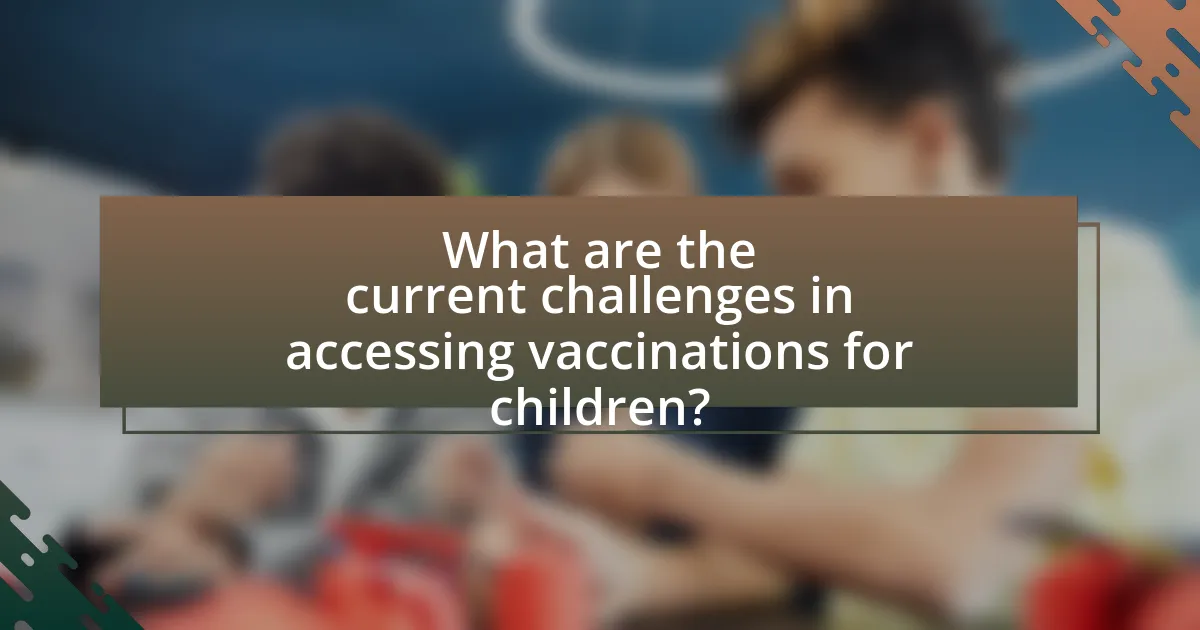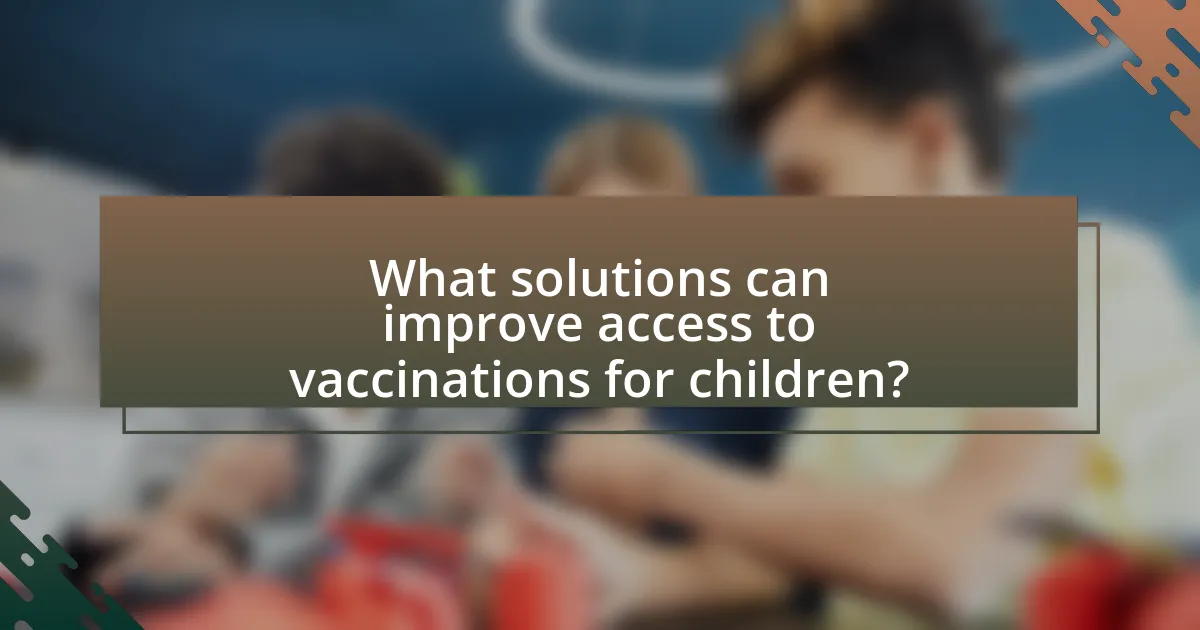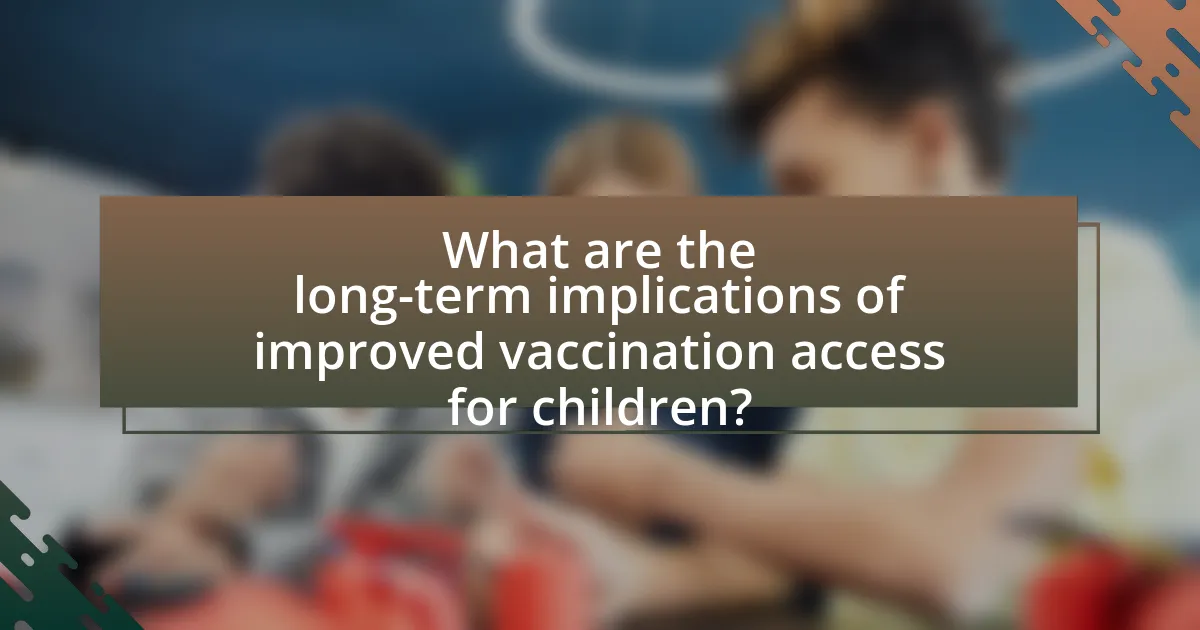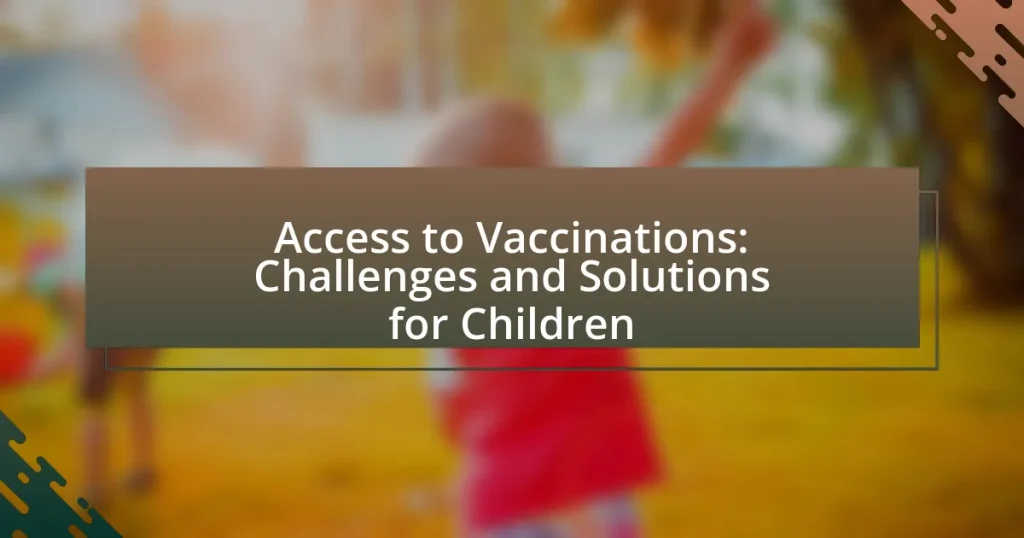Access to vaccinations for children faces significant challenges, including logistical barriers, misinformation, and socioeconomic factors. Logistical issues often stem from inadequate healthcare infrastructure, particularly in rural areas, while misinformation about vaccine safety contributes to hesitancy among parents. Socioeconomic disparities further complicate access, as low-income families may lack transportation and health insurance. The article explores these challenges in detail, examining how geographic barriers, misinformation, and healthcare system limitations impact vaccination rates. It also discusses potential solutions, such as community outreach programs and mobile vaccination units, aimed at improving access and ultimately enhancing public health outcomes.

What are the current challenges in accessing vaccinations for children?
Current challenges in accessing vaccinations for children include logistical barriers, misinformation, and socioeconomic factors. Logistical barriers arise from inadequate healthcare infrastructure, particularly in rural areas, where clinics may be scarce or lack necessary supplies. Misinformation about vaccine safety and efficacy can lead to hesitancy among parents, further complicating access. Socioeconomic factors, such as poverty and lack of health insurance, prevent families from seeking vaccinations, as they may face transportation issues or cannot afford associated costs. According to the World Health Organization, these challenges have contributed to a decline in vaccination rates in various regions, highlighting the urgent need for targeted interventions.
Why do disparities in vaccination access exist?
Disparities in vaccination access exist due to socioeconomic factors, geographic location, and systemic inequalities. Research indicates that low-income communities often face barriers such as lack of transportation, limited healthcare facilities, and insufficient health insurance coverage, which hinder their ability to receive vaccinations. For instance, a study published in the American Journal of Public Health found that children from families with lower socioeconomic status are significantly less likely to be fully vaccinated compared to their higher-income counterparts. Additionally, rural areas may have fewer healthcare providers and vaccination sites, exacerbating access issues. These factors collectively contribute to unequal vaccination rates among different populations.
What socioeconomic factors contribute to vaccination access issues?
Socioeconomic factors such as income level, education, and geographic location significantly contribute to vaccination access issues. Individuals with lower income often face financial barriers, including the inability to afford transportation to vaccination sites or the cost of vaccines themselves, even when they are subsidized. Education plays a crucial role, as those with lower educational attainment may lack awareness of vaccination schedules and the importance of immunization, leading to lower vaccination rates. Additionally, geographic location affects access, with rural areas often having fewer healthcare facilities and providers, resulting in limited availability of vaccination services. According to the Centers for Disease Control and Prevention, disparities in vaccination coverage are evident, with lower rates observed in populations with lower socioeconomic status, highlighting the impact of these factors on public health outcomes.
How do geographical barriers affect vaccination rates?
Geographical barriers significantly reduce vaccination rates by limiting access to healthcare facilities and services. In rural or remote areas, individuals often face long distances to travel for vaccinations, which can lead to lower participation rates. For instance, a study published in the American Journal of Public Health found that children living more than 30 miles from a vaccination site were less likely to be vaccinated compared to those living closer. Additionally, geographical barriers can exacerbate socioeconomic disparities, as low-income families may lack transportation or resources to reach vaccination centers, further decreasing vaccination uptake.
What role does misinformation play in vaccination access?
Misinformation significantly hinders vaccination access by creating fear and distrust among parents and communities. This distrust can lead to decreased vaccination rates, as evidenced by a study published in the journal “Vaccine,” which found that misinformation about vaccine safety correlates with lower immunization coverage. Furthermore, misinformation can spread rapidly through social media platforms, amplifying false narratives and contributing to vaccine hesitancy. The World Health Organization has identified vaccine hesitancy as one of the top ten global health threats, highlighting the critical impact of misinformation on public health initiatives aimed at increasing vaccination access.
How does social media influence public perception of vaccines?
Social media significantly influences public perception of vaccines by shaping information dissemination and community discussions. Platforms like Facebook and Twitter allow for rapid sharing of both accurate and misleading information, impacting individuals’ beliefs and attitudes toward vaccination. For instance, a study published in the journal “Vaccine” found that misinformation on social media can lead to increased vaccine hesitancy, as users often trust peer opinions over expert recommendations. Additionally, the World Health Organization reported that social media is a major source of health information, which can amplify both positive and negative narratives about vaccines, ultimately affecting public trust and vaccination rates.
What are common myths surrounding childhood vaccinations?
Common myths surrounding childhood vaccinations include the belief that vaccines cause autism, that they contain harmful levels of toxins, and that natural immunity is better than vaccine-acquired immunity. Research published in the journal “Annals of Internal Medicine” found no link between vaccines and autism, debunking this myth. Additionally, vaccines undergo rigorous testing to ensure safety, and the amounts of any substances, such as thimerosal, are well below harmful levels. Furthermore, studies indicate that vaccinated children are less likely to contract diseases compared to those who rely solely on natural immunity, which can lead to severe health complications.
How do healthcare systems impact vaccination access?
Healthcare systems significantly impact vaccination access by determining the availability, affordability, and distribution of vaccines. For instance, countries with robust healthcare infrastructures often have organized immunization programs that ensure vaccines are readily available in clinics and hospitals, leading to higher vaccination rates. According to the World Health Organization, regions with well-functioning healthcare systems can achieve vaccination coverage rates exceeding 90%, while areas with weak systems may struggle to reach even 50%. Additionally, healthcare policies, such as those that provide free vaccinations or integrate immunization into routine healthcare services, directly influence public uptake and accessibility.
What are the limitations of current healthcare policies regarding vaccinations?
Current healthcare policies regarding vaccinations face several limitations, including inconsistent access, lack of public awareness, and insufficient funding. Inconsistent access arises from disparities in healthcare infrastructure, particularly in rural and underserved urban areas, where vaccination services may be limited or unavailable. Lack of public awareness contributes to vaccine hesitancy, as misinformation about vaccine safety and efficacy spreads, undermining public confidence. Insufficient funding for vaccination programs restricts outreach efforts and the availability of vaccines, particularly in low-income communities. According to the World Health Organization, approximately 19.4 million infants worldwide did not receive basic vaccines in 2021, highlighting the impact of these policy limitations on global vaccination efforts.
How does the availability of healthcare providers affect vaccination rates?
The availability of healthcare providers significantly influences vaccination rates by determining access to immunization services. When healthcare providers are readily available, individuals are more likely to receive vaccinations due to increased convenience and reduced barriers to access. For instance, a study published in the American Journal of Public Health found that areas with a higher density of healthcare providers had vaccination rates that were 20% higher compared to regions with fewer providers. This correlation highlights that greater provider availability facilitates timely vaccinations, thereby improving overall public health outcomes.

What solutions can improve access to vaccinations for children?
Improving access to vaccinations for children can be achieved through mobile vaccination units, community outreach programs, and partnerships with local healthcare providers. Mobile vaccination units can reach underserved areas, ensuring that children in remote locations receive necessary immunizations. Community outreach programs educate parents about the importance of vaccinations and provide logistical support, such as transportation to vaccination sites. Collaborating with local healthcare providers can enhance trust and facilitate easier access to vaccination services, as evidenced by studies showing increased vaccination rates in communities with strong healthcare partnerships.
How can community outreach programs enhance vaccination access?
Community outreach programs enhance vaccination access by increasing awareness and providing resources directly to underserved populations. These programs often involve local health workers who build trust within communities, facilitating better communication about the importance of vaccinations. For instance, a study published in the American Journal of Public Health found that targeted outreach efforts led to a 20% increase in vaccination rates among children in low-income neighborhoods. By addressing barriers such as transportation, language, and cultural misconceptions, community outreach initiatives effectively improve vaccination uptake and ensure that more children receive necessary immunizations.
What strategies have proven effective in increasing vaccination rates in underserved areas?
Community engagement and outreach programs have proven effective in increasing vaccination rates in underserved areas. These strategies include partnering with local organizations, utilizing trusted community leaders to disseminate information, and providing mobile vaccination clinics to improve accessibility. For instance, a study published in the American Journal of Public Health found that community-based interventions, such as door-to-door outreach and educational workshops, significantly increased vaccination uptake among low-income populations. Additionally, offering incentives, such as food vouchers or transportation assistance, has been shown to further encourage participation in vaccination programs.
How can schools play a role in promoting vaccinations?
Schools can play a crucial role in promoting vaccinations by implementing educational programs that inform students and parents about the benefits and safety of vaccines. Research indicates that schools are trusted environments where health information can be effectively disseminated, leading to increased vaccination rates. For instance, a study published in the American Journal of Public Health found that school-based vaccination campaigns can increase immunization coverage by up to 20%. Additionally, schools can facilitate access to vaccinations by partnering with local health departments to provide on-site vaccination clinics, making it more convenient for families to immunize their children.
What policies can governments implement to improve vaccination access?
Governments can implement policies such as subsidizing vaccination costs, enhancing public awareness campaigns, and increasing the availability of vaccination sites to improve vaccination access. Subsidizing costs can reduce financial barriers, as evidenced by programs in countries like Australia, where the National Immunisation Program provides free vaccines to children, resulting in higher vaccination rates. Public awareness campaigns can educate communities about the importance of vaccinations, as seen in the CDC’s initiatives that have successfully increased vaccination uptake by addressing misinformation. Additionally, increasing the number of vaccination sites, including mobile clinics and partnerships with schools, can make vaccines more accessible, as demonstrated by initiatives in the United States that have expanded access in underserved areas, leading to improved vaccination coverage among children.
How can funding and resources be allocated to support vaccination initiatives?
Funding and resources can be allocated to support vaccination initiatives by prioritizing investments in healthcare infrastructure, community outreach programs, and partnerships with local organizations. Allocating funds to enhance healthcare facilities ensures that vaccines are stored and administered properly, while community outreach programs can educate populations about the importance of vaccinations, increasing uptake rates. Collaborating with local organizations can leverage existing networks to distribute resources effectively, as evidenced by the World Health Organization’s initiatives that have successfully increased vaccination coverage in underserved areas.
What role do public health campaigns play in increasing vaccination awareness?
Public health campaigns play a crucial role in increasing vaccination awareness by disseminating accurate information and addressing misconceptions about vaccines. These campaigns utilize various media platforms to educate the public on the benefits of vaccination, thereby enhancing community knowledge and acceptance. For instance, the Centers for Disease Control and Prevention (CDC) reported that targeted campaigns during outbreaks significantly increased vaccination rates, demonstrating the effectiveness of strategic communication in promoting immunization.
How can technology be leveraged to improve vaccination access?
Technology can be leveraged to improve vaccination access by utilizing mobile health applications, telemedicine, and data analytics. Mobile health applications facilitate appointment scheduling and reminders, ensuring that caregivers do not miss vaccination dates. Telemedicine allows healthcare providers to offer consultations and guidance remotely, which is particularly beneficial in underserved areas. Data analytics can identify vaccination trends and gaps in coverage, enabling targeted outreach efforts. For instance, a study published in the Journal of Medical Internet Research found that mobile health interventions increased vaccination rates by 20% in low-income populations. These technological solutions collectively enhance accessibility and efficiency in vaccination programs.
What are the benefits of using mobile health applications for vaccination reminders?
Mobile health applications for vaccination reminders enhance adherence to vaccination schedules by providing timely notifications and personalized reminders. These applications improve vaccination rates by ensuring that caregivers receive alerts about upcoming vaccinations, which can lead to a significant increase in on-time immunizations. For instance, a study published in the journal “Vaccine” found that mobile reminders increased vaccination rates by 20% among parents who used such applications compared to those who did not. Additionally, these applications often include educational resources about the importance of vaccinations, further motivating caregivers to comply with recommended schedules.
How can telehealth services facilitate vaccination consultations?
Telehealth services can facilitate vaccination consultations by providing remote access to healthcare professionals, enabling parents to receive guidance and information about vaccinations without needing to visit a clinic. This approach increases convenience and reduces barriers such as transportation issues or time constraints, which are significant challenges for many families. A study published in the Journal of Medical Internet Research found that telehealth consultations can improve vaccination rates by making it easier for parents to discuss concerns and schedule appointments, ultimately leading to higher compliance with vaccination schedules.

What are the long-term implications of improved vaccination access for children?
Improved vaccination access for children leads to significant long-term health benefits, including reduced incidence of vaccine-preventable diseases. Enhanced vaccination coverage contributes to herd immunity, which protects vulnerable populations and decreases the overall burden on healthcare systems. For instance, the World Health Organization reported that widespread vaccination has led to a 73% reduction in measles deaths globally between 2000 and 2018. Additionally, improved vaccination access fosters healthier childhood development, as children are less likely to suffer from complications associated with preventable diseases, ultimately resulting in better educational outcomes and economic productivity in adulthood.
How does increased vaccination access impact public health outcomes?
Increased vaccination access significantly improves public health outcomes by enhancing herd immunity and reducing the incidence of vaccine-preventable diseases. When more individuals receive vaccinations, the overall population immunity increases, which protects those who cannot be vaccinated, such as infants or individuals with certain medical conditions. For instance, the World Health Organization reported that widespread vaccination has led to a 73% reduction in measles deaths globally between 2000 and 2018, demonstrating the direct correlation between vaccination access and disease control. Furthermore, increased vaccination access can lead to lower healthcare costs associated with treating outbreaks, as fewer individuals require hospitalization for preventable diseases.
What are the potential reductions in disease outbreaks with higher vaccination rates?
Higher vaccination rates can significantly reduce disease outbreaks by creating herd immunity, which protects those who are unvaccinated. For instance, a study published in the journal “Vaccine” found that increasing vaccination coverage for measles to 95% can lead to a 90% reduction in outbreaks. Similarly, the World Health Organization reports that high vaccination rates against polio have led to a 99% decrease in cases globally since 1988. These statistics demonstrate that higher vaccination rates directly correlate with lower incidence and spread of infectious diseases.
How does vaccination access influence herd immunity in communities?
Vaccination access significantly influences herd immunity in communities by determining the proportion of the population that is immunized against infectious diseases. When vaccination access is high, a larger percentage of individuals receive vaccines, which reduces the overall spread of disease and protects those who cannot be vaccinated, such as infants or individuals with certain medical conditions. For instance, studies have shown that communities with vaccination coverage above 90% can achieve herd immunity for diseases like measles, effectively preventing outbreaks. Conversely, limited access to vaccinations leads to lower immunization rates, increasing susceptibility to disease transmission and compromising herd immunity, as evidenced by the resurgence of measles in areas with declining vaccination rates.
What are the economic benefits of improving vaccination access?
Improving vaccination access leads to significant economic benefits, including reduced healthcare costs and increased productivity. When vaccination rates rise, the incidence of vaccine-preventable diseases declines, resulting in lower medical expenses for families and healthcare systems. For instance, the CDC estimates that every dollar spent on childhood vaccinations saves approximately $3 in direct healthcare costs and about $10 in additional societal costs, such as lost productivity due to illness. Furthermore, healthier populations contribute to a more robust workforce, enhancing economic output and stability. Thus, improving vaccination access not only protects public health but also fosters economic growth and efficiency.
How can reduced healthcare costs be achieved through higher vaccination rates?
Higher vaccination rates can achieve reduced healthcare costs by preventing disease outbreaks and minimizing the need for expensive medical treatments. Vaccines significantly lower the incidence of infectious diseases, which in turn decreases hospitalizations and healthcare expenditures. For example, the Centers for Disease Control and Prevention (CDC) estimates that childhood vaccinations prevent approximately 21 million hospitalizations and 732,000 deaths among children born in the last two decades, resulting in savings of about $295 billion in direct healthcare costs. By increasing vaccination coverage, communities can enhance herd immunity, leading to fewer cases of preventable diseases and ultimately lowering the overall financial burden on the healthcare system.
What is the impact on workforce productivity with improved child health from vaccinations?
Improved child health from vaccinations significantly enhances workforce productivity. Healthier children lead to a more capable future workforce, as they experience fewer illnesses, resulting in reduced absenteeism and increased cognitive development. According to a study published in the journal “Health Affairs,” every dollar spent on childhood vaccinations can yield a return of approximately $3 in economic benefits due to increased productivity and reduced healthcare costs. This correlation underscores the importance of vaccinations in fostering a healthier population that contributes effectively to the economy.
What practical steps can families take to ensure their children receive vaccinations?
Families can ensure their children receive vaccinations by scheduling regular appointments with healthcare providers and keeping track of vaccination records. Consistent communication with pediatricians about vaccination schedules helps families stay informed about upcoming immunizations. Additionally, utilizing reminders through healthcare apps or calendars can prompt families to adhere to vaccination timelines. Research indicates that children who receive vaccinations on time are less likely to contract preventable diseases, highlighting the importance of proactive health management.
